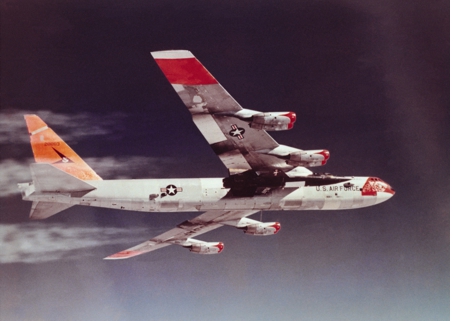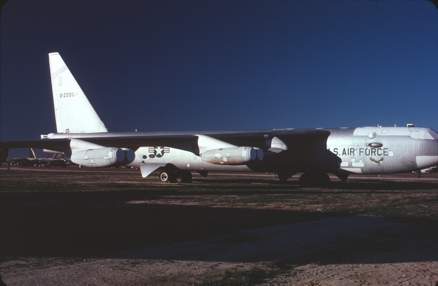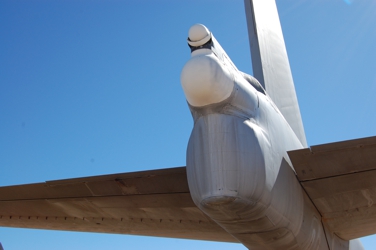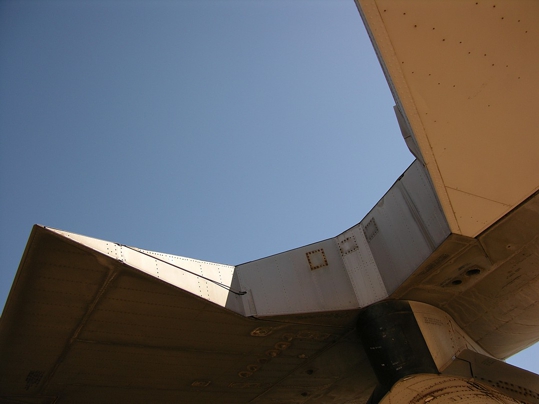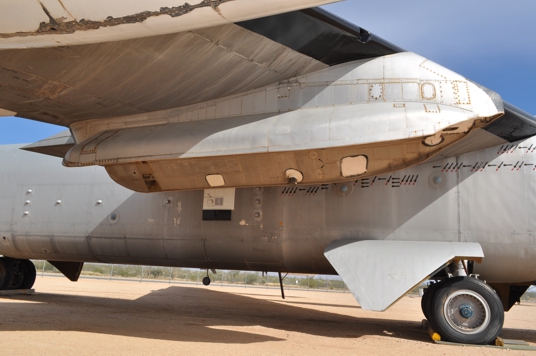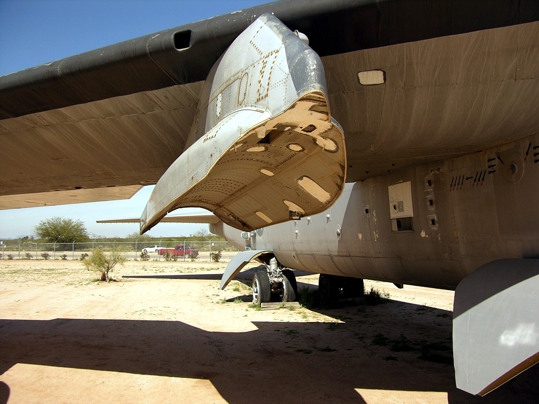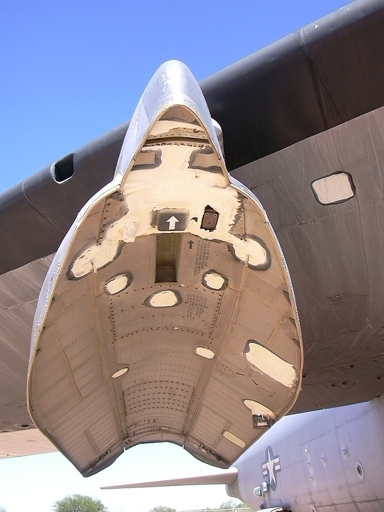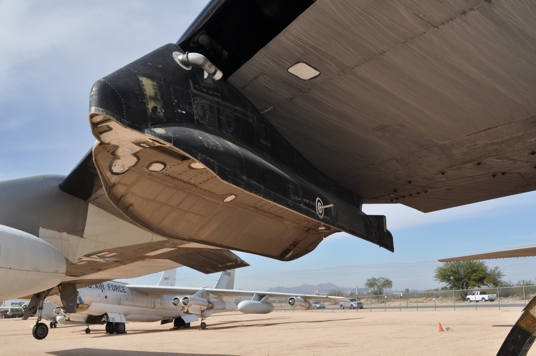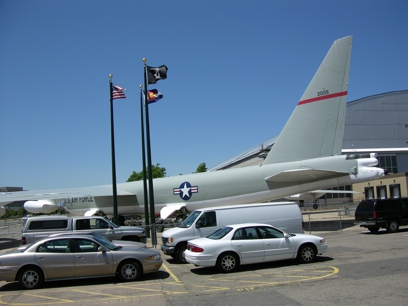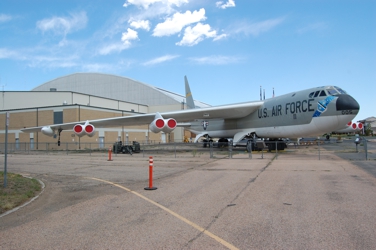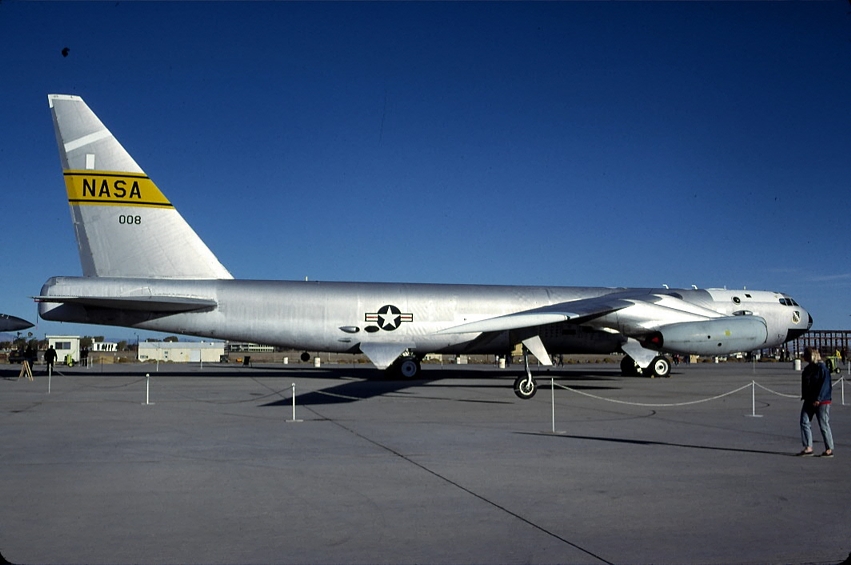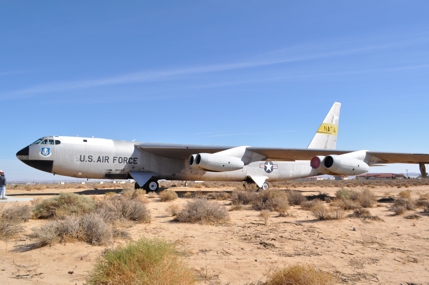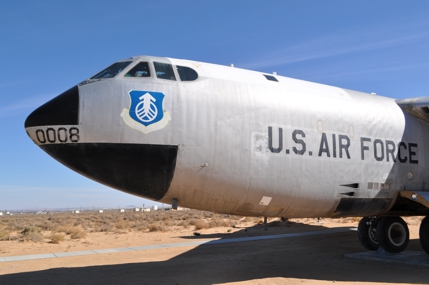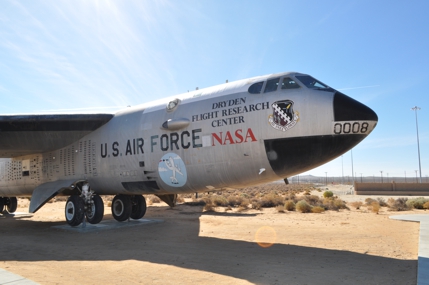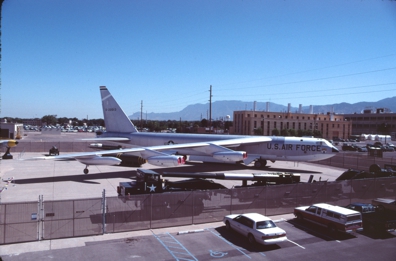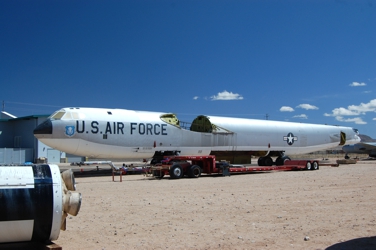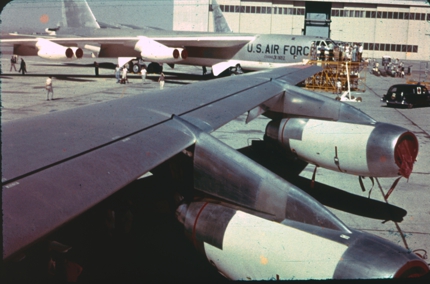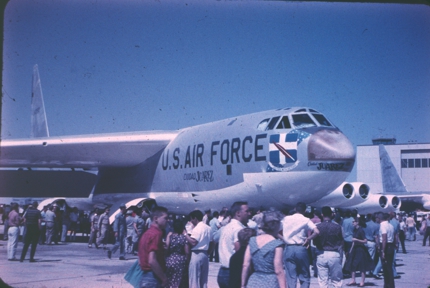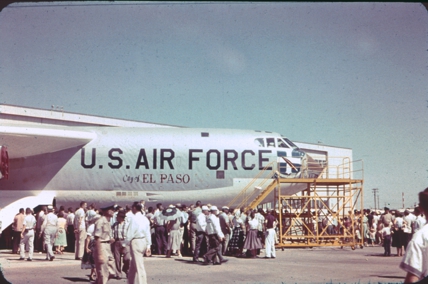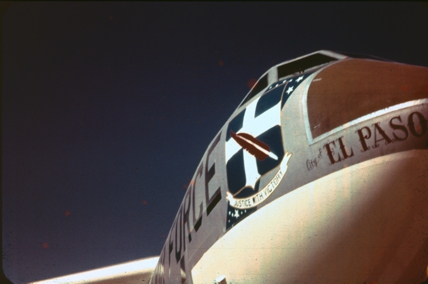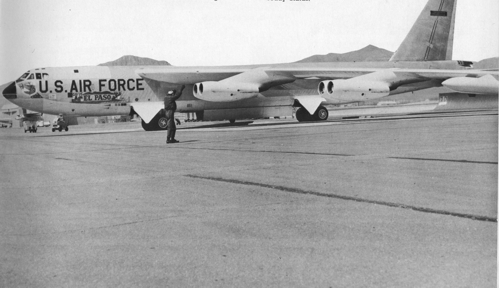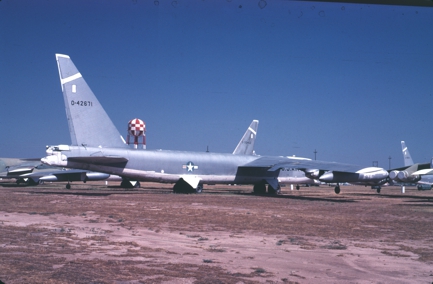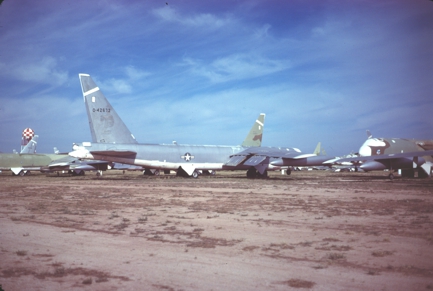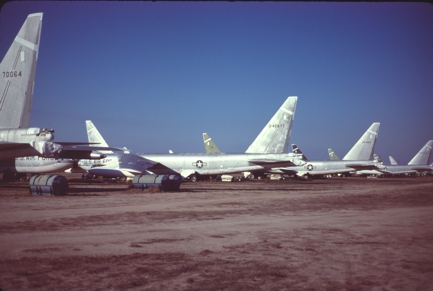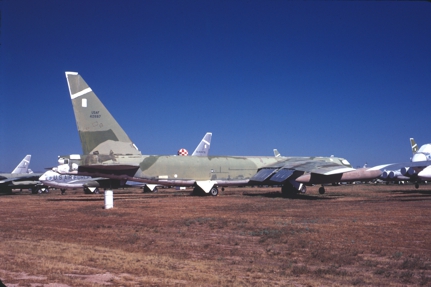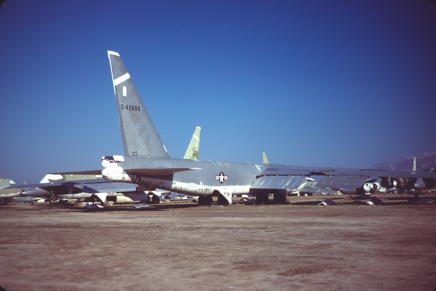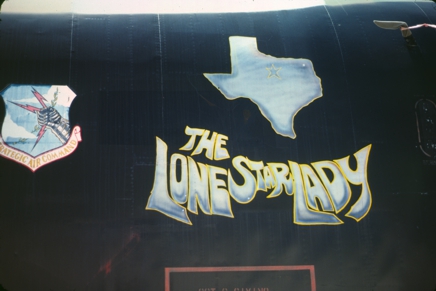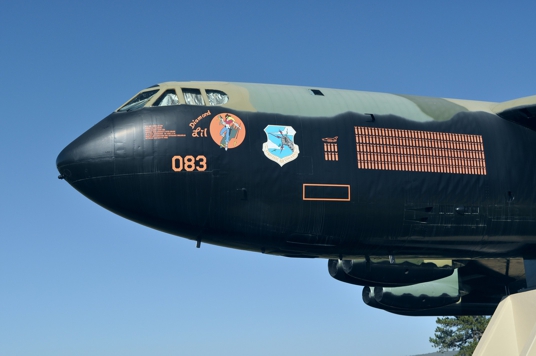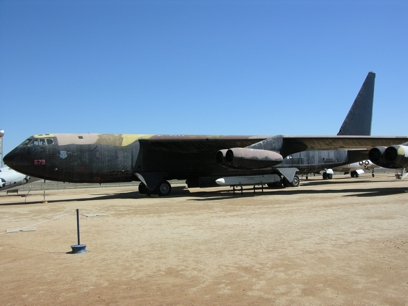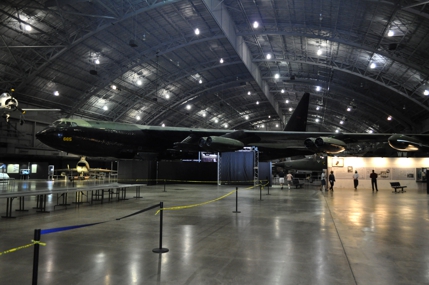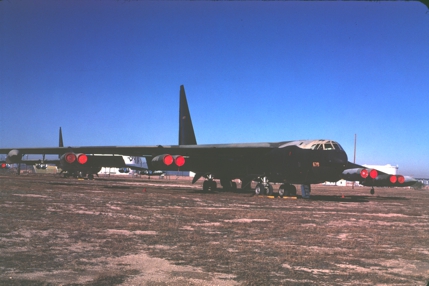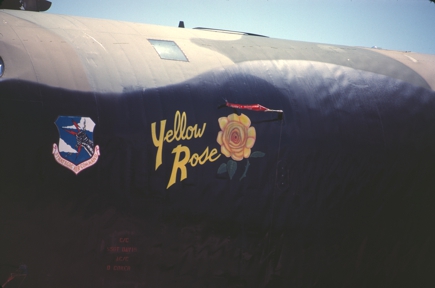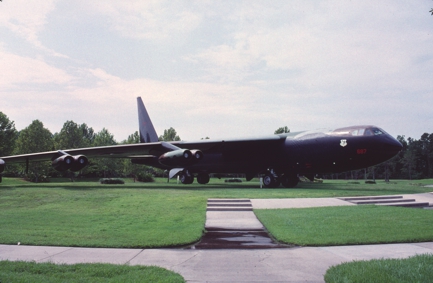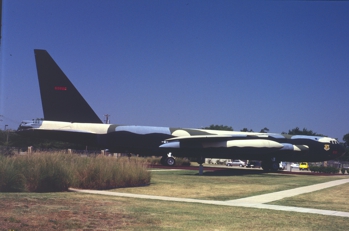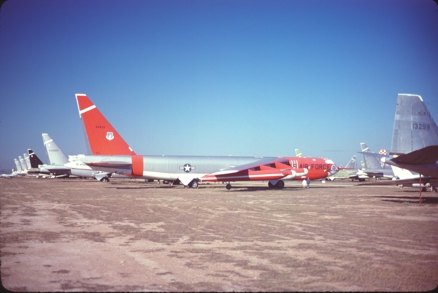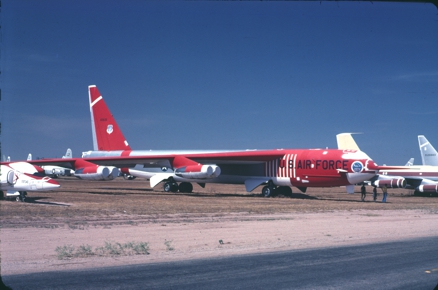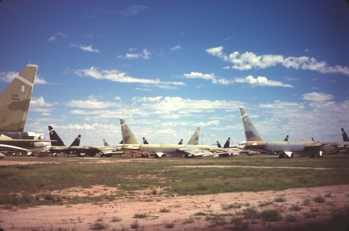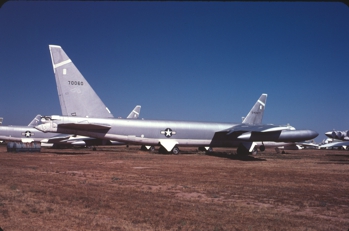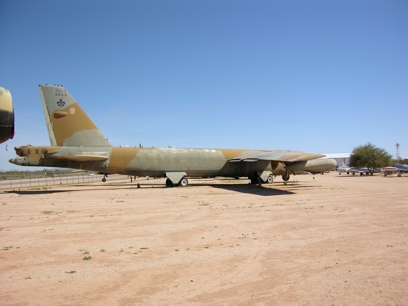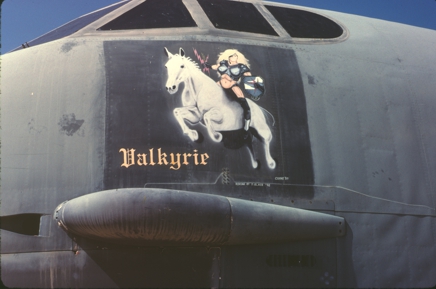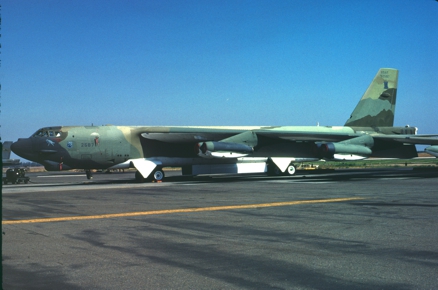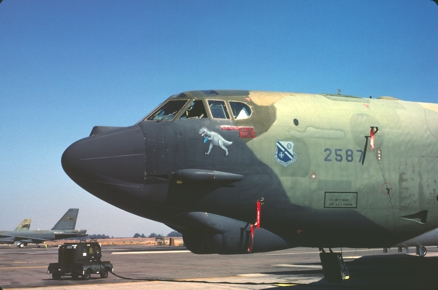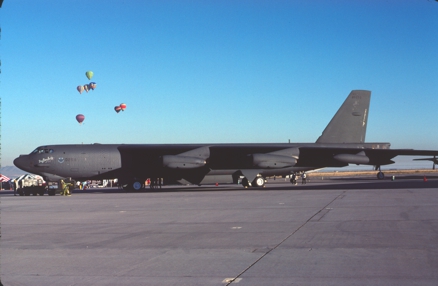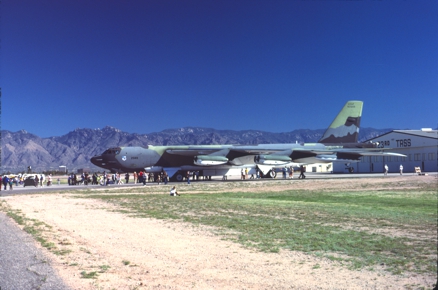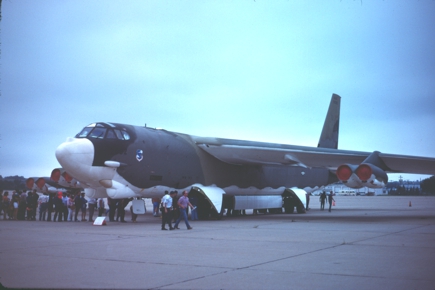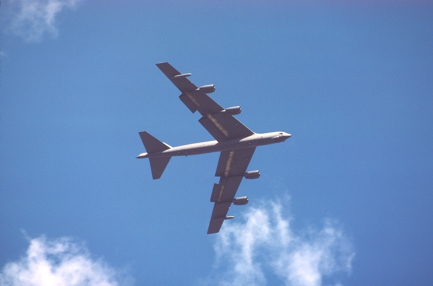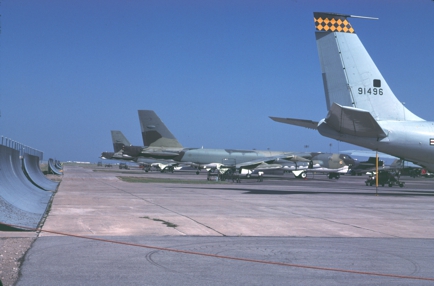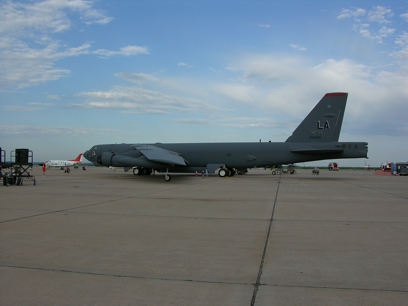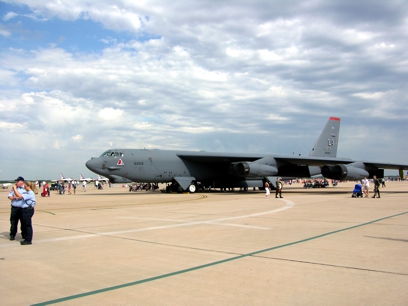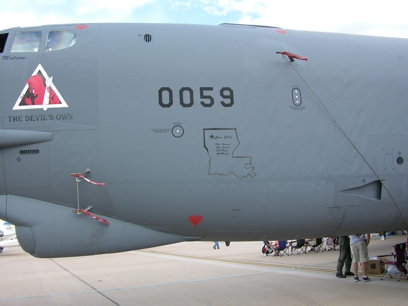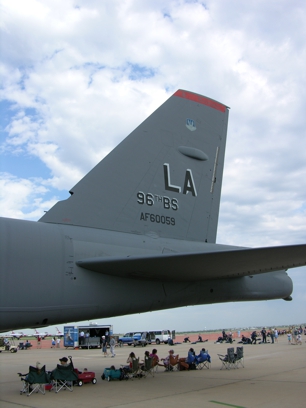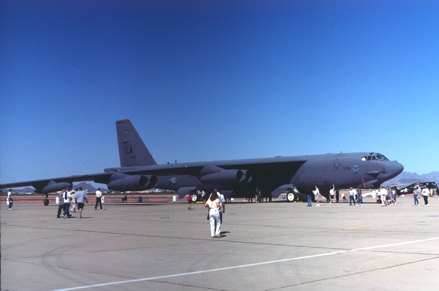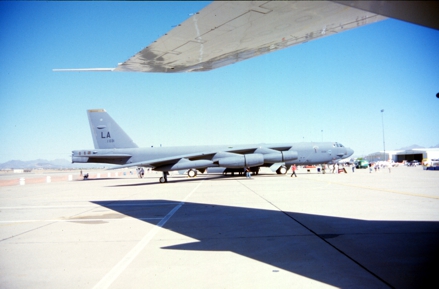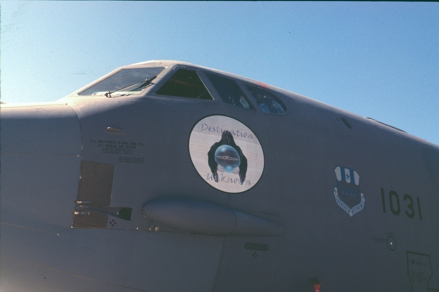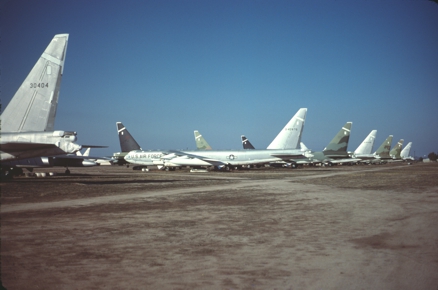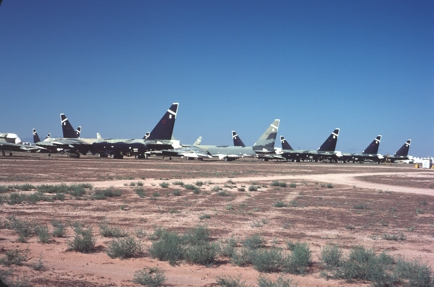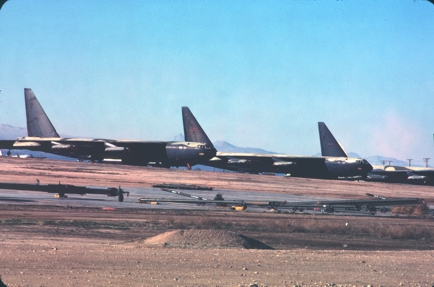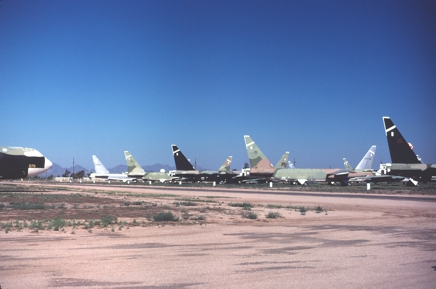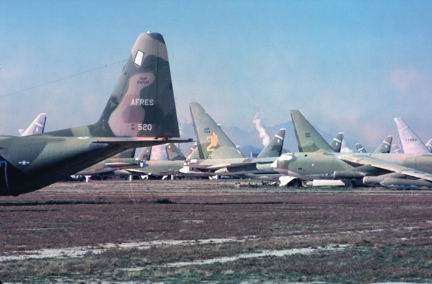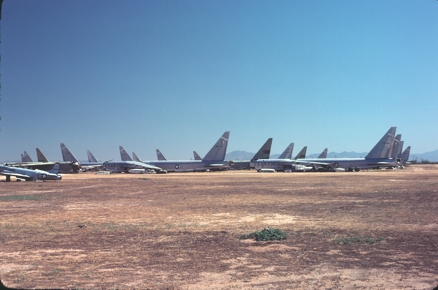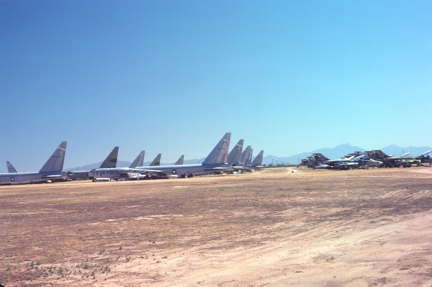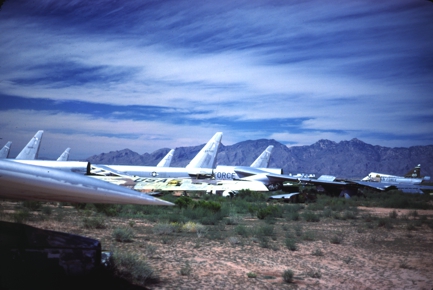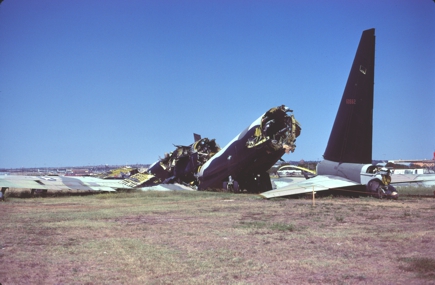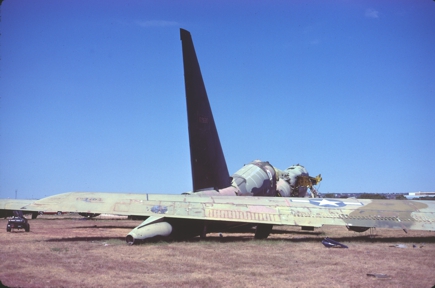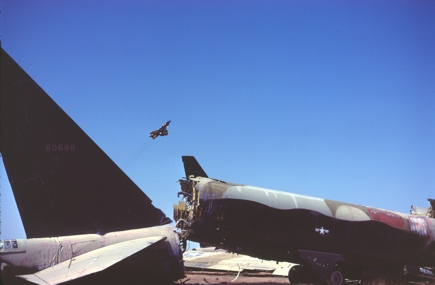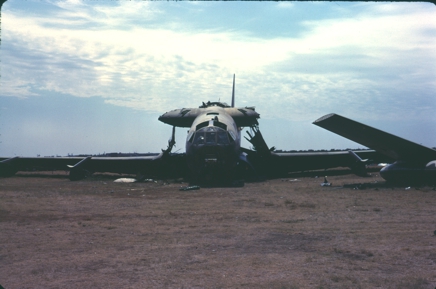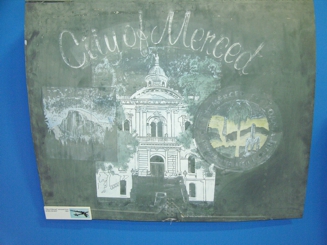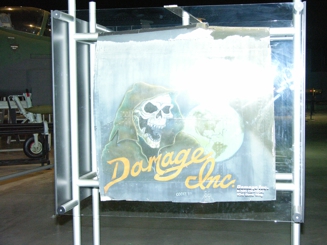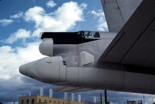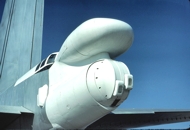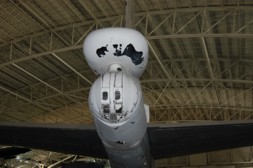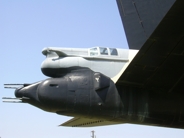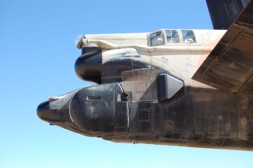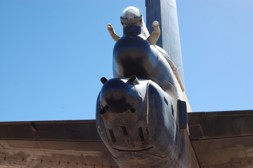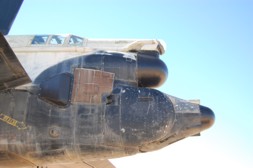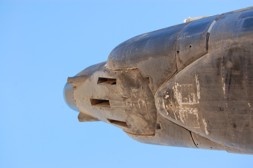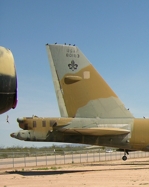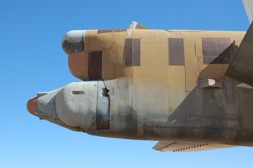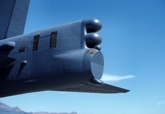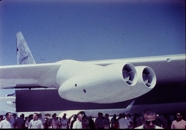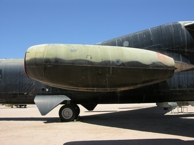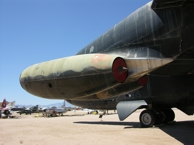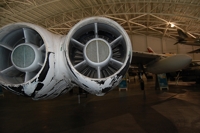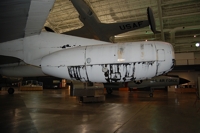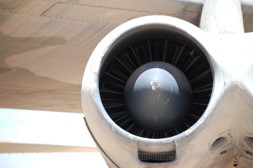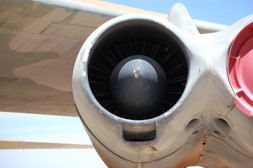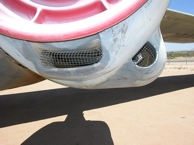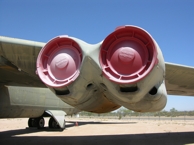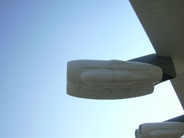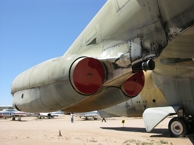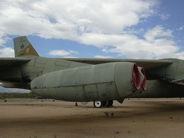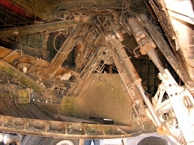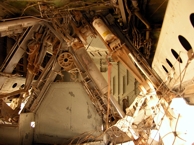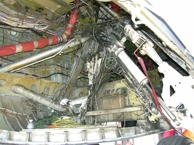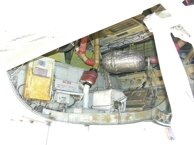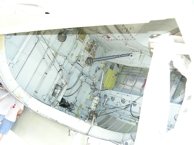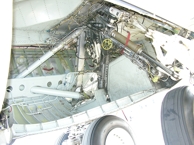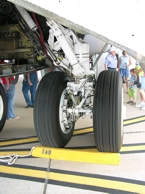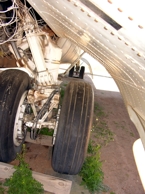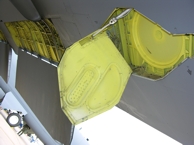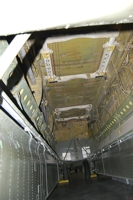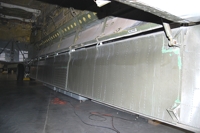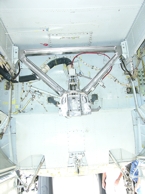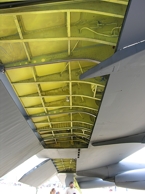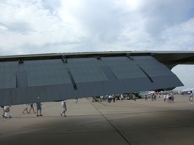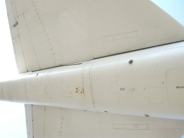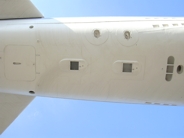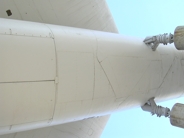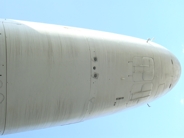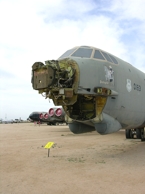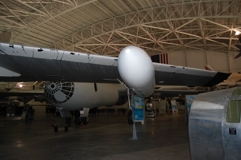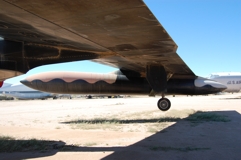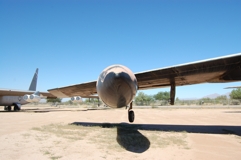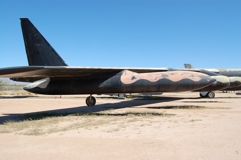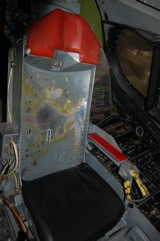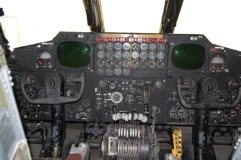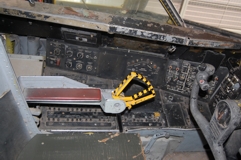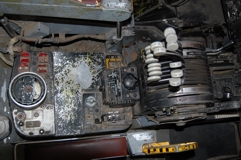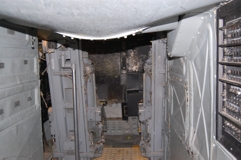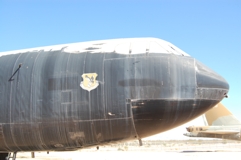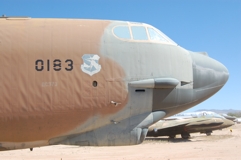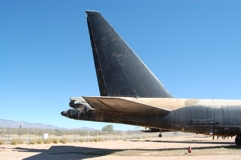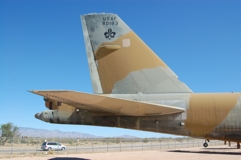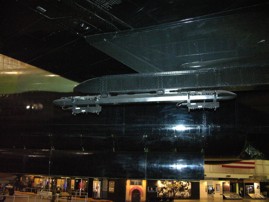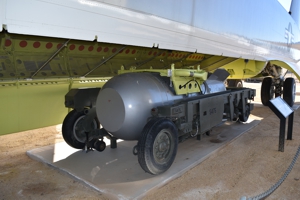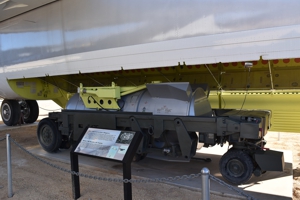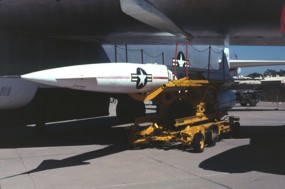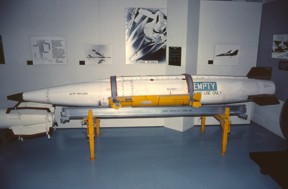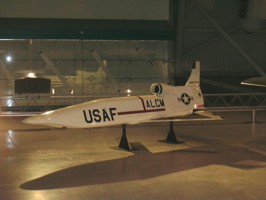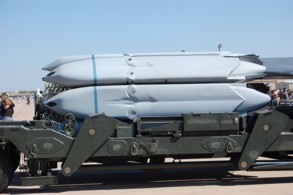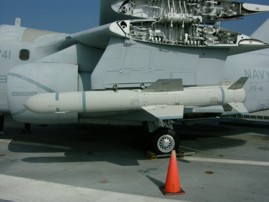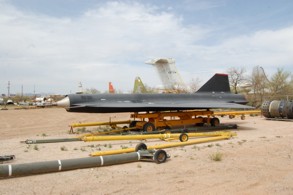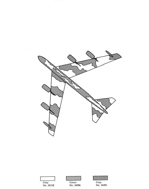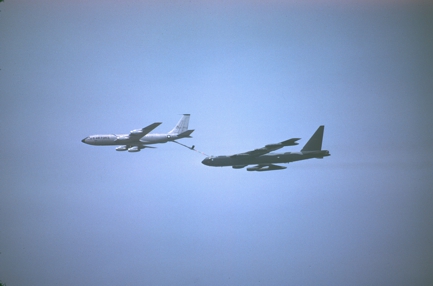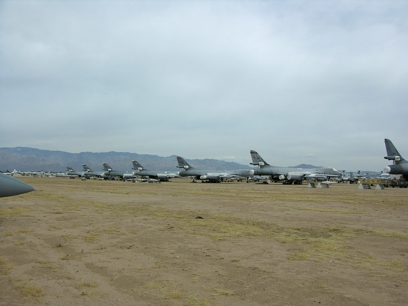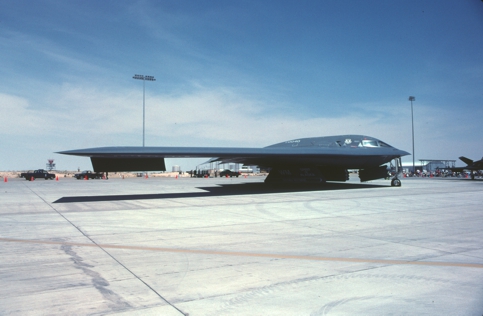The
B-52 Stratofortress
(A half assed attempt at photo
coverage of a great bomber)
Click the
photos for larger images.
B-52A
NB-52A 52-0003 which was used by NASA for many drop tests,
but is usually best remembered as the X-15 "Mother
ship". (NASA)
This
aircraft was stored at MASDC (now AMARG) for
many years before being placed on display at the Pima Air
& Space Museum. The second photo is of "Balls
Three" at MASDC in 1978 and the third shows her on display
at Pima in 2005.
The first panel
shows NB-52A 52-0003 which was used by NASA for many drop
tests, but is usually best remembered as the X-15 "Mother
ship". (NASA)
This
aircraft was stored at MASDC (now AMARG) for many
years before being placed on display at the Pima Air &
Space Museum. The second photo is of -003 at MASDC in
1978 and the third shows her on display at Pima in 2005.
The
second panel shows drop markings, photo resolution panel
and camera mods.
The
final panel shows the X-15 cradle and a notch in the right
wing to allow for the tail of the X-15.
A couple
of X-15 photos to accompany the above photos. 56-6671 is
an X-15A-2 on display at the National Museum of the United
States Air Force. The aircraft labeled as 56-6672 is
actually a full scale mock up on display at the NASA Dryden
Center located at Edwards AFB. The actual 6672 was
destroyed in a fatal crash in 1967.
B/RB-52B
B-52B 52-0005 on display at the
Wings Over The Rockies
air museum in June, 2005 and in August, 2008.
NB-52B 52-0008 at Edwards
AFB. This was the replacement for -0003 and itself was
eventually replaced with a B-52H. That aircraft was also
retired about 2010. (unknown)
The three other photos show "Balls Eight" as displayed at the
north gate of Edwards AFB in November, 2014.
RB-52B 52-0013 at the National Atomic Museum,
Kirtland AFB, 2000. This airplane had served with the Air
Force Special Weapons Center (AFSWC) for many years. In
April of 2009 the museum moved to a new location just off base
and became the National
Museum of Nuclear Science and History. Moving the
outside exhibit is a major effort and as of late April the B-52
was still awaiting re-assembly.
RB-52B 52-8711 at the old SAC Museum, Bellevue NE, 1992.
When this photo was taken in August, 2007 the aircraft had been
moved inside at the new Strategic Air
& Space Museum in Ashland, Nebraska where she is
finally receiving some well earned TLC. At one time she
was repainted in a spurious SIOP scheme, which still shows
through the top color.
B-52B 53-380 ("Ciudad Juarez") of the 95th BW. This aircraft was
accidentally shot down by a 188th TFS (New Mexico Air
National Guard) F-100A on April 7, 1961, with the loss of
three lives. Hard to believe, but an AIM-9
Sidewinder is capable of downing even such a large
aircraft. (John
Paul Jones)
B-52B
53-388
95th
BW.
This
is the first "City of El Paso". Photo and the one
above date from 1959.
Note
the
MD-5 fire control system with twin 20mm cannons rather than
the A-3A system with quad .50 cal machine guns. (JohnPaulJones)
B-52B
53-394
95th BW. This was the second "City of El Paso".
It was delivered to the USAFM only to be scrapped in the late
'80s. (unknown)
This
photo
is from a "year book" on the 95th BW. Note the
unnecessary censoring of the aircraft serial number.
Hope the censor suffered a couple of months of constipation.
(USAF)
B-52C
B-52C 54-2671, 99th
BW. MASDC 1979.
Tail of the a/c to the left. See the "winged 8" (for the
8th AF) on the tail? MASDC 1979.
B-52C 54-2672 last served with
the 509th BW before being placed in storage at MASDC in
1971. This BUFF also carries a winged 2.
B-52C 54-2677 at MASDC in 1979.
B-52C 54-2687 at MASDC in June of 1979. This aircraft
wears a very worn SIOP scheme.
B-52C 54-2688 at MASDC in February
1980.
B-52D
The SEA scheme with a black belly and tail was unique
to the B-52D. The first three photos are of 55-0067
displayed at the Pima Air & Space Museum. It was
placed on display shortly after the last B-52Ds were retired
in 1983.
The last photo is of 55-0068 on display at Lackland
AFB. This photo was taken in 2000.
55-0083 is displayed at the United States Air Force Academy
as a tribute to the crews that have flown the B-52 in
combat. "0083" is one of two B-52s credited with
air-to-air kills of MiG-21s.
55-0679
is shown on display at the March Field Air Museum at March ARB
in March, 2007. This B-52D last served as an
instructional airframe with the 22nd BW.
The Flight Test Museum at Edwards AFB has B-52D 56-0585 on
display, photographed in November, 2014. Unfortunately
as of August, 2015 this aircraft is in the process of being
scrapped. It will be replaced by "Balls 8", which is
currently displayed outside the North gate at Edwards.
The Castle Air Museum displays 56-0612. Shown here in
1989.
56-0617 was a guest at the Holloman AFB open house in 1979.
Before being placed in storage at MASDC 56-0620
had served with the Air Force Special Weapons Center at
Kirtland AFB. She had been in retirement for several
years when this photo was taken in 1978.
Formerly with the 96th BW, 56-0626 is shown at MASDC in
1978.
The scale of this hangar is evident where The National
Museum of the United States Air Force displays 56-0665
indoors in this 2011 photo.
56-0678 is shown
shortly after arrival at MASDC in 1978. One of the
last of the Connies (C-121) is in the background.
Yellow Rose, 56-0679 is on display at
Carswell AFB in 1981. Within two years she would be
flown to MASDC and placed in storage.
The Orlando International Airport has 56-0687 on permanent
display. The Orlando airport was the former site of
McCoy AFB, hence the IATA code for Orlando is MCO.
Along
with numerous other aircraft, 56-0695 is
displayed at the Airpark just outside the
gates to Tinker AFB. She is shown here
on a hot, sticky day in July, 2003.
B-52E
 |
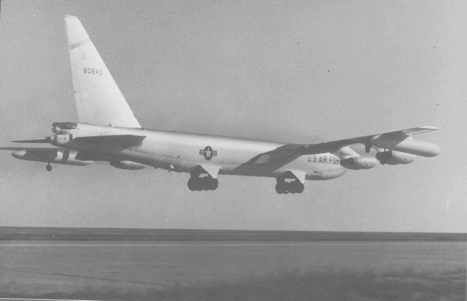 |
6th BW B-52E
56-0634 at an airshow, Biggs AFB. Probably about
1960. (I wonder if I am the little brat running into
the photo?) (John
Paul Jones)
6th BW B-52E 56-0640, landing at Walker AFB, about
1965. When the 6th BW flew B-29s and B-36s they used a
stylized "Pirate head" emblem on the right side of the
aircraft nose. The emblem applied to the B-52s was more
in line with the official patch. (USAF)
NB-52E 56-0632 was modified
into the CCV "Control Configured Vehicles".
B-52F
57-0035 is shown at MASDC in
1979. This color scheme is known as SIOP and
consists of two greens (FS595A 34079 and 34159) and
a tan (34201) over gloss white. This scheme was used
on all B-52s still in service by the late 60s with the
exception of the B-52D.
57-0038 in 2003. This B-52F had been on
display at the Oklahoma City Fairgrounds for decades, but
in 2006 she was removed and transported to the Joe Davis
Heritage Airpark in Palmdale, California.
Acres of B-52Fs at MASDC in 1979. Note the
variations in colors though many are in the same scheme.
57-0060 in the classic silver over white.
B-52F
57-0139 (93d BW?) MASDC 1980.
B-52F 57-0183 AFSWC . This was the replacement for
52-0013 (top of page). MASDC 1979.
Short
tailed
BUFFs
B-52G
Over
the years B-52s would return to Biggs Field for
deployments. In 1989 the 416th BW from Griffiss AFB was
deployed for about two weeks. 57-6516 is rolling out
after landing at Biggs.
The B-52G fleet was retired after Desert Storm,
making some airframes available to museums. The Pima
Air & Space museum acquired 58-0183. When '183"
went into storage at AMARG she was still sporting
artwork. Over the years the museum has met the
challenge of maintaining that art.
The
nose section of 58-0232 is on display at the Hangar 25
Museum in Big Spring, Texas. Big Spring was the home
of Webb AFB. For some time I had misidentified this
aircraft as a B-52H.
Nose
art made a comeback during the 1980s and some of it was rather
imaginative. This is B-52G 59-2587 Stratofortress Rex of the 93rd BW
at Castle ASB in August, 1989.
59-2589 at the
Davis-Monthan open house in 1987.
B-52G
59-2592 was with the 319th BW when photographed at Offutt AFB
in July, 1981. She is shown again going into storage at
AMARC in 1993 after serving with the 2nd BW during Desert
Storm.
During the 1980s the B-52G fleet was tasked with
the ALCM mission. In an agreement with the Soviet
Union those 98 aircraft modified to carry cruise missiles
received a fairing on the leading edge of the wing
root. This would make them identifiable in satellite
photos The curved fairing can be seen in this photo.
B-52H
B-52H 60-0060 of the 5th BW
at Biggs AAF during a "Bare Base" excersise in 1982.
60-0052 among other
B-52s at Carswell AFB in 1985.
60-0054 on final at
Carswell in March, 1988. At the time the 7th Bomb
Wing used a long horn marking on the tail of their B-52Hs
and KC-135s.
61-0005 of the 7th BW in August,
1985. This is about the same spot B-52D 56-0679 was
parked at when photographed in 1981.
61-0023 at Carswell in 1984.
Current estimates
assume that the B-52H will possibly remain in service until
2040. 60-0059 named The Devil's Own was on
display at the Dyess AFB open house in May, 2006.
Maybe she will be there again for several decades.
The
current overall gray scheme (FS595B 36118) is shown on
B-52H 61-0031 (Destination
Unknown) at the 2003 Davis-Monthan Open
House.
During 1983 the 7th Bomb Wing at
Carswell AFB lost the venerable B-52Ds to "newer"
B-52Hs. B-52H 61-0035 leads a line of B-52Ds.
Photos are mine unless
otherwise noted.
MASDC / AMARC / AMARG
From 1964 until 1985 the aircraft storage area at Davis-Monthan
AFB was called the "Military Aircraft Storage and
Disposition Center", or MASDC, usually pronounced as
"Mazdik". It
then became the "Aerospace Maintenance and Regeneration
Center" (AMARC), commonly called "A-Mark". In 2007 that became the "Aerospace
Maintenance and Regeneration Group" (AMARG).
Various models of B-52s
in storage during 1978. 1st in line is NB-52A
52-0003, which is now displayed at the Pima Air &
Space Museum. B-52Bs (and RB-52Bs) had been retired
by mid 1966, the 95th BW loosing theirs in June of that
year. The B-52E followed in 1970 and the B-52Cs the
following year. The B-52Fs were retired by the end of
1978. The B-52D held out until 1984, but it finally
too was retired leaving NASA's NB-52B, 52-0008 as the sole
"Tall Tailed" B-52 in operation.
B-52Ds
began to arrive in large numbers in the late 1970's and
were parked among various other types where space was
available.
The end of the road.
MASDC 1980. Cutting up B-52s is nothing new. At
first landing gear and engines were removed, with the aircraft
sitting on their bellies and then slowly cannibalized.
Quite often other aircraft mixed in among them: T-33s, RF-101Fs
and even a Pennsylvania TF-102.
With the retirement of
the B-52G fleet it did not take too long before they too
were being salvaged.
58-0249
in the process of being turned into scrap at AMARG in June,
2007. Fortunately, the artwork removed is now on
display at the National Museum of the United States Air
Force in Dayton, Ohio.
B-52Ds 56-0662, 0680 and 688 at Carswell
AFB in 1985 after having been destroyed in compliance with the
START Treaty. These forlorn BUFFs remained in this
location for several months while Soviet satellites verified
they were indeed dead.
As the B-52G was destroyed an effort was made to preserve
some of the art work with the majority preserved at the National
Museum of the USAF.
Some art is also preserved at Pima, like Hoosier Hot Shot, B-52G
57-6486.
Surprise Attack is from
58-0162 and is at Pima also.
The NMUSAF has a great nose art display in the Cold War Hangar.
Whats Up Doc 58-0182.
58-0207 was christened The City
of Merced when assigned to the 93rd BW. This art
work has suffered from several years of exposure at AMARC before
being placed on display inside at Pima.
Damage Inc is from
58-0254 and is now safely out of the elements at the NMUSAF.
BUFF Parts
Tail Positions/Guns
Tail
armament evolved throughout the production of the
B-52. The system used for the three B-52As, seventeen
of the B/RB-52Bs and all but the final B-52C was the A-3A
Fire Control system that controlled four M3 .50 caliber
machine guns. The other thirty three B/RB-52Bs used
The MD-5 Fire Control System, with a pair of M-24A-1 20mm
cannons. The last B-52C (54-2688) introduced the MD-9
FCS which reverted to four .50 cals. This latter
system was used through the B-52F. With all tall
tailed BUFFs the tail gunner was in the tail separated from
the rest of the crew. This changed with the B-52G,
when the gunner was moved forward with the rest of the
flight crew. The G still carried the four MG armament,
but used the AN/ASG-15 FCS. With the B-52H the "fifty
cals" were replaced with a six barreled M61 "Vulcan" 20mm
cannon controlled through the AN/ASG-21 FCS. By the
1990s the guns had been removed to make way for various ECM
equipment.
The first photo in the
above panel shows the A-3A FCS and tail gun position as
carried by the B-52A, 17 of the B/RB-52Bs (serials
54-004/013, 53-392/398) and all but one B-52C.
The second, third and fourth photos show the MD-5 FCS and
20mm guns used on most RB/B-52B aircraft.
This set of panels shows the MD-9 FCS used on the last
B-52C and all B-52D/E/F airframes.
The tail shot of a B-52G illustrates the AN/ASG-15 FCS and
quad .50 guns. The tail is noticeably different now
that the gunner has been moved forward with the rest of
the crew. During the 1970s Phase VI ECM upgrades
added a 40 inch plug aft of the stabilizers.
The profile of the B-52H tail changed even more with the
AN/ASG-21 FCS and the M61 Vulcan.
During 1991 the Vulcan was removed as was the gunner.
Engine nacelles
Early J-57 powered B-52s
(A, B, C, D and E)
(YJ-57-P-3,
J-57-P-1, -1W, -1WA, -1WB, -19-W, -29W and -29WA
engines.)
The earlier J-57 powered B-52s
featured a very smooth nacelle, with few protrusions
or openings.
The photos in this
panel show a B-52B circa 1959 and three photos of the
B-52D on display at the Pima Air and Space Museum taken in
2007.
These five photos
show the nacelle of an RB-52B (52-8711) taken at the
Strategic Air & Space Museum in Ashton, NE. The
first two photos show the opening for the air driven
alternator in the center of the engine. (2007)
Later J-57 powered B-52s
(F and G)
(J-57-P-43-W and -43-WB
engines.)
The later J-57 powered variants had a bulge on the left
side of each nacelle that housed a hard driven
generator.
TF-33 Powered B-52Hs
(TF-33-P-3 and P-103)
The above photos are
of Pima's B-52G 58-0183. (2007)
Landing gear
Main gear and wheel wells
These photos do not
do justice to the complexity of the B-52 wheel wells, but
they do give a hint. The above photos were taken of
the B-52D on display at Pima and everything in the wells
have a thorough coating of dust.
The above photos were
taken inside the wells of a B-52H at Dyess AFB in May,
2006. Even though much cleaner, they still show
years of use.
The main gear was
similar on all B-52 types. The gear itself was
usually either painted silver, or white.
Outriggers (or more
correctly Tip Gear)
I had always referred
to these as "outriggers", but was recently corrected by a
BUFF crewman who stated that when he crewed B-52s they
were called Tip Gear.
The Bomb bay
RB-52B 52-8711
These photos
illustrate the 1960s vintage B-52 bomb bay. RB-52B
52-8711 is preserved at the Strategic Air & Space
Museum in Ashland, Nebraska. The views are: forward,
bay door looking forward and the view aft. (2007)
B-52H 60-0059
The whole purpose of
the B-52 was to carry bombs and most were carried
internally. This B-52H has been modified with a
rotary launcher to field such weapons as ALCMs, JDAMs and
JSOWs.
Flaps
This
series of photos illustrates the flaps on a B-52H.
During 2005 Pima refurbished fiberglass radomes and
other parts of various airplanes. Their B-52G received
some nose work at that time.
External Fuel Tanks
B-52B and RB-52B aircraft
The initial drop tanks were
rather small on the B-52B and RB-52Bs, carrying 1,000
gallons of fuel.
B-52C,
B-52D, B-52E and B-52F aircraft
The B-52C,
D, E and F versions had a larger tank, of 3,000 gallon
capacity.
B-52G and B-52H aircraft
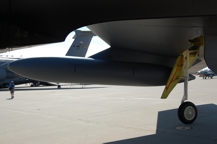 |
 |
B-52G and H
Stratoforts had a wet wing and therefore did not need as
large of external tanks. The tanks on these
versions are similar to the tanks on the earliest
versions, but carrying only 700 gallons and being
permanently attached.
Interior
These photos show the interior of the B-52 crew trainer
on display at the Strategic Air & Space Museum in
Ashland, Nebraska. While BUFFs would change over
the years they do give a good idea of the B-52 cockpit
layout.
These photos are also from the same simulator. The
first shot shows the overhead panel mainly comprised of
circuit breakers. The second picture shows the
center console and throttles, with the instrument panel
as a background. The main gear "crabbing" control
is the prominent dial in the lower center. The
last photo is of the aircraft commanders seat.
These photos are of the interior of B-52G 58-0232 on
display at the Hangar 25 Museum in Big Spring,
Texas. This aircraft was used as a trainer at
Goodfellow AFB before going to the museum. The
interior is well worn and many items are missing.
These views show some areas buried behind the
cockpit. The first view is looking forward towards
the cockpit. The second view is looking aft
towards the EWo and Gunner position. The third
view is of the Navigator and Radar Navigator position
below the cockpit.
Noses
and Tails
The nose of the B-52 remained very similar from the A
model until the F. With the introduction of the
B52G the nose changed slightly on it and the H.
The difference became more noticeable with the addition
of EVS and other systems.
The original tail design gave the BUFF and overall
height of 48' 3". This was the tall Tail as used
on the B-52A through B-52F. The tail on the B-52G
and H was shortened by almost eight feet giving them a
height of 40' 8"/
Ordnance
As the purpose of the
B-52 was to put bombs upon enemies it
would be remiss to not include the
weapons carried by the BUFF. The
Stratofortress has carried a wide
variety of stores. This section
will try to cover those weapons carried
by the B-52.
When pylons were not
fitted to the aircraft the area where
they would be mounted was covered by
fairings. The last photo shows the
fairing removed and the brackets where
the pylon would attach.
The under wing pylons
were designed to carry conventional
ordnance and that proved handy in Viet
Nam. A couple of MERs were
attached to each pylon allowing the
carriage of twelve bombs per
pylon. The original pylons were
designed to carry Hound Dog missiles,
but as those were in demand for SAC
units standing alert a shorter pylon was
developed. A Heavy Stores Adapter
Beam (HSAB) was attached to the short
pylons carry ordnance. Supposedly
the pylons attached to Hound Dog
missiles were assigned to individual
airframes.
Nuclear
Weapons
 |
 |
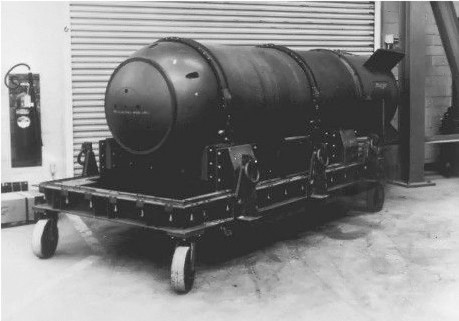 |
 |
Mark 5
|
Mark 6
|
Mark 15
|
Mark 17
|
 |
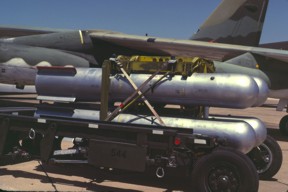 |
 |
 |
Mark 28IN
|
Mark 28RI
|
Mark 36
|
Mark 39
|
 |
 |
 |
 |
Mark 53
|
B-43
|
B-61
|
B-83
|
As illustrated by the above photos the
B-52 was capable of carrying a wide
range of nuclear weapons. In most
cases the BUFF could carry several of
any type. In the case of the Mk 17
however that was limited to one due to
the shear size of the bomb. A more
detailed guide to nuclear weapons can be
found on a page devoted to free fall Nukes.
Mark 53 under the B-52B on display at the
National Museum of
Nuclear Science and History, in Albuquerque,NM. The
left bomb bay door has been removed. This was not
necessary to load the weapon as the door folded flush with
the fuselage. It is removed purely for display purposes.
Conventional munitions
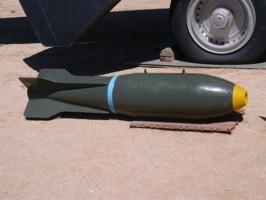
|
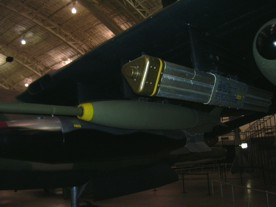
|

|

|
Mk 117 750
lbs bomb
|
Mk 81 250
lbs bomb
|
Mk 82 500
lbs bomb low drag
|
Mk 82
500lbs bomb Retarded ("Ballute")
|
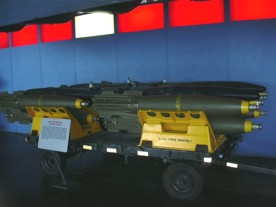
|
 |
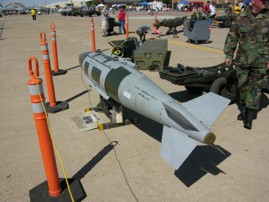 |
 |
Mk 82 500
lbs bomb ("Snake-eye")
|
Mk 84
2,000 lbs bomb
|
GBU-31
JDAM (2,000 lbs)
|
GBU-31
JDAM |
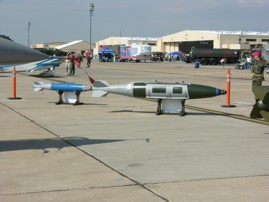 |
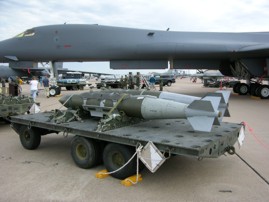 |
 |

|
GBU-32
JDAM (1,000 lbs)
|
GBU-38
JDAM (500 lbs)
|
AGM-154
JSOW
|
CBU-58
|

|

|
|
|
CBU-89
|
Mk 20
"Rockeye"
|
|
|
Stand off weapons
The AGM-28 Hound Dog
was developed in the late 1950s to serve
the role of an air launched cruise
missile. It enjoyed a fairly
successful life and was not removed from
the inventory until 1978. The only
B-52 models not modified to carry the Hound Dog
were the B-52B and RB-52B aicraft, all
other models would carry the missile in
time. The Hound Dog
carried a W-28 thermonuclear variable
yield warhead of 500 kiloton to 4
megaton. The Hound Dog
was powered by a Pratt & Whitney
J-52 engine. One advantage
of using a jet was that the
missile could be fueled from the
carrying B-52. A pair of Hound Dogs
could also be used to provide additional
power in high max gross takeoff
conditions.
The AGM-69 SRAM
(Short Range Attack Missile) was
developed to provide bombers with an
attack capability after the cancellation
of the Skybolt program. The SRAM
is able to deliver a W-69 warhead of 200
kt yield out 100 miles. The B-52,
FB-111A, B-1B and B-2A are all capable
of carrying the SRAM.
The AGM-69 ALCM (Air
Launched Cruise Missile) and CALCM
(Conventional Air
Launched
Cruise Missile)
were another weapon designed for carry
by bombers. The AGM-69B ALCM
(left) and AGM-69C CALCM (right)
illustrate the weapon with wings
extended and wings folded. The
AGM-69Cs are attached to a rotary
launcher carried by B-1Bs. In the
nuclear role the ALCM is fitted with a
W-80 thermonuclear warhead of 200 kt
yield. The CALCM carries a
conventional warhead. The B-52H is
able to carry twelve on each pylon and
eight in the bomb bay on a rotary
launcher for a total of twenty.
The AGM-129 Advanced
Cruise Missile has a lower radar
signature than the ALCM does. Like
the AGM-69 it is powered by a turbo fan
engine and can carry the W-80 warhead.
Originally developed
for the Navy the AGM-84 Harpoon was
later adapted for use by the B-52.
While not a weapon,
the ADM-20 Quail was concevied to be
carried in the bomb bay of the
B-52. Its purpose was to provide a
decoy image on Soviet radar allowing the
B-52 to reach its objective. A
B-52 could carry four Quails as well as
a reduced bomb load. However, the
ADM-20 became ineffective by the early
70's and was removed from service.
The B-52 was capable
of carrying the D-21 drone, though it
was not common. In fact it appears
that very few missions were actually
carried out (probably no more than five)
under a program called Senior
Bowl.
BUFF Colors
Early B-52s left the factory in a
natural metal finish. The lettiring on the forward
fuselage was a small "UNITED STATES AIR FORCE" in Insignia
Blue (FS 15044). Radomes were black and the SAC
"Milky Way" band was not carried. With the B-52C
the white "Anti-Flash" belly was introduced along with a
larger "U.S. AIR FORCE" on the forward section. The
SAC band was added and on most aircraft the lower nose
radome was painted an off white. The B-52B and RB-52B
received this scheme as they were cycled through depot
maintenance, though on some RB-52Bs the SAC band was applied
aft of the wing. All subsequent B-52s would receive
the silver over white scheme at the factory, which would
remain in effect until camouflage made an appearance in the
1960s. Some silver B-52s in later life appear to
be sprayed silver rather than a natural metal finish.
 |
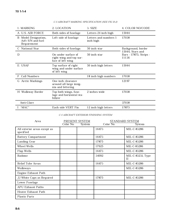
|
This page out of T.O. 1-1-4 EXTERIOR FINISHES, INSIGNIA
AND MARKINGS APPLICABLE TO USAF AIRCRAFT shows an
Arctic B-52 scheme that while probably never carried on any
BUFF does give reference to the placement of markings.
 |
 |
The
first B-52s to gain camo were some B-52Es that served in
South East Asia. They received a coat of black paint
sprayed over the white bellies to make them less visible
from below at night. During the mid 1960s two schemes
were created. What is usually referred to as the SIOP
scheme was used on all B-52s remaining in service while the
B-52Ds were painted is a scheme that is often called SEA,
though it differed in colors from the TAC SEA scheme and
only differed from the SIOP scheme is using black on the
underside instead of white and having a black vertical
tail. The colors for the SIOP scheme were Tan (FS
34201), Dark Green (34079), SAC Green (34159) and White
(17875). As mentioned the SEA only differed in using
Black instead of White.
The SIOP scheme was used on B-52C/E/F/G/H aircraft.
The SEA scheme was only used on the B-52D.
 |
By
the 1980s only the B-52D/G/H aircraft were left in
service. During the early 1980s SAC felt that the big
white nose on SIOP BUFFs was just to conspicuous, so the
nose area was painted in Gray (36081). This was an
interim scheme until a new one was developed. The
remainder of the B-52D fleet was retired in 1983 and no
changes were made to the SEA scheme.
A new
scheme came around for the B-52G/H fleets in the early 1980s
and included a pattern for the lower surface as well as the
top. The top pattern consited of Green (34086) and
Euro One Gray (36081), the lower Euro One Gray (36081) and
Gunship Gray (36118). This scheme was replaced by the
current overall gray though some B-52Gs were retired in the
early 1990s still in this pattern.
By
the late 1980s a single color scheme was fielded.
Initially overall Euro One Gray (36081) was used, but by
1992 the shade was changed to the slightly lighter Gunship
Gray (36118). This is the current (2017) scheme, but
as long as the Stratofortress is expected to stay in service
it might not be the last. While not as appealing as
the Silver/White scheme it is preferable to the 1980s
scheme.
And the B-52's
replacement is!
Ta-da!
Oops, that did not happen.
Okay,
okay, this is it!
Oh no, not that either.
Wait, wait, here it is!
Well, maybe not after all.
Well. This will do the trick!
Guess that remains to be seen.
In reality none of the bombers above were really meant
as a replacement for the BUFF. The B-70 program was
envisioned to be the bomber of the future, but early in
its developement it was realized that a high altitude
bomber was no longer viable.
The B-1 was to supplant the B-52 until the Stealth Bomber
came into being.
The FB-111 was spawned during Robert S. McNamara's reign
of goofiness and though a good strike aircraft it was
never meant as a serious B-52 replacement..
The B-2 has not been built in the numbers needed to
replace the B-52, but it is a system that provides
capability well beyond its numbers. Time alone will
see the end to the B-52's service life.

|
This memorial at the United States Air Force Academy
is dedicated to the B-52 and the crews that have flown her
through the years.



Clifford Bossie
Page created 12-04-01
Modified 01-18-20
A note on the photographs: The
majority of photos used on this site are mine. And a
majority of those were taken as slides. I started
using ASA 25 Kodachrome, but due to availability problems
I sometimes substituted ASA 64. As time went
by and family responsibilities took
priority I shot fewer photos. Over time
Kodachrome became more difficult to purchase and the a
fore mentioned responsibilities came first I could
not order Kodachrome in bulk. I was then forced to
buy Elitechrome, which was just a fancy name for
Ecktachrome, which is a fancy name for "crap". Over
time I have been able to scan many slides to digital,
which is part of the reason for the photo overload on this
page. After scanning hundreds of slides all I can
say is "Thank God for digital cameras!"
